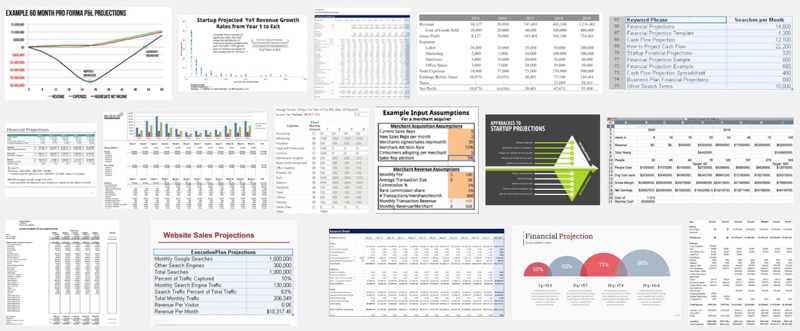
I've reviewed thousands, maybe tens of thousands of pitch decks, covering early, growth and late stage venture capital and private equity. There's a flow to presenting the argument of a business opportunity that can create a mind meld between an entrepreneur and an investor, where you're able to spend your time appropriately around the key insights, bets, and questions behind the product, business, and team. Good pitches aren't just pitches, but conversations.
Yet far too often, I've seen a great flow break down when it comes time to discuss the financials. After slides full of crisp, clear illumination of the problem, solution, market, team and plan, the financials are often left to a header like "Financial Summary" and a screen capture of a five year projection of revenues, costs, and net income, and perhaps the ever-present hockey stick of growth of revenues, users, subscribers. Flow, killed.
But why?
My plan is conservative.
No, it's probably not, and even if it is, presenting a set of three or five year financial projections and then confidently calling it conservative misses the point. Why do investors, as is the common rule of thumb, take a look at a set of projections and cut it in half? The heuristics "it takes twice as long to get done" or "it takes twice as much money" are easy, simple ways to adjust a model that are often proved true when plans hit the real world, but the reason behind the dance is more nuanced.
Convervative or not, the reason why an investor doesn't believe an entrepreneur's projections often isn't in the projections themselves but the way they are displayed and presented.
How can you have a good conversation about a business with a slide like any of these?

Don't make anyone figure out your key points. Tell them directly.
Neither a chart of projected growth nor a screen capture of a three to five year projected income statement works because it doesn't make the story clear. Most slides in a deck work to simplify the key insight and present data to construct the argument; but in these cases, all of the data is presented, usually without commentary, without making the key insights clear. It's left up to the reviewer - the investor - to make their insights, and usually, we simply don't. We focus on other areas of analysis because we can use our gut and our instincts around human and corporate behavior to ground our thoughts, but with this, we have no context, no bearing, no easy way to benchmark or understand the story.
Highlight operational fundamentals, not just financial projections.
The thing is, a three to five year projection isn't how an entrepreneur thinks. When you're getting started, you're not thinking about what revenue will be in three years, we're focused on two fundamentals:
- Does the business work on a per-customer basis at any point in the business?
- Can the business grow?
A chart obscures the instinctual analysis we do when we think about our businesses. It hides many conflicting trends happening in the business, and obscures the simple questions we ask ourselves. Does it solve a problem, will people pay for it, can we provide it for less than it costs us, and can we grow it.
That's the better way to talk about and present the financials for a business: show how it works, show how it can grow, and show it's big.
User economics
Per-user eonomics are key. This is whay SaaS businesses are obsessed with LTV (long-term value) and CAC (customer acquisition cost) and many other customer metrics, because they have to focus on how a business makes money on a per-customer basis. It's not as simple as LTV greater than CAC, though: time to breakeven matters, upsell and expansion opportunities matter, MRR (marginal recuring revenue) matters, and many other metrics matter because they tie back to fundamental user economics. Solid growth can obscure poor user economics, but only for so long.
For help in creating and communicating your unit economics, download the free Unit Economics Forecasting for Excel and Google Sheets →
Market size
There's a reason why we - entrepreneurs and investors - care about market size. Sizing a market is hard to reduce to a set of formulas in Excel, and while we can do all the data analysis possible to forecast one's market size, they are still data points, not the answer. Markets can change if you change what people do. And that's why presenting a market sizing isn't as simple as stating how many people bought something this past year, or what a research firm projects people will spend three years from now: they are data points to help make your argument, but you still have to tell the full story.
If you've proven that the user economics can work and that the market is large enough, then you're left with one more question:
- What will it cost to find out?
Prove that you understand your costs
Interestingly, cost budgets are much easier for us to discuss. An entrepreneur can (generally) control their costs, but will have far less control over adoption of their product, and thus their revenue projections will be far more variable than their cost projections. That's what a cost budget frames the conversation around: what will it cost to find out if the business can work?
And this is key: the cost budget is important because it shows that you've thought about what it takes to actually build the business. It shows a plan for how you will spend the money you raise from investors. It shows you are thinking about who you need to hire, what you need to focus on, how you plan to balance your priorities over a specific timeframe in order to achieve key milestones for your business.
Key milestones could include:
- X number of customers, or users
- Key product launches
- Key results from beta users
- Signals of "proof" that the business is worth investing further capital into
The level of detail for a cost budget depends on the level of the business: the more unknowns in the business, the less detail the cost budget needs to have. Focus on hiring (what roles, when, and how much), acquisition costs (if you will be spending on acquisition), and major expenses related to building the product and the business.
The key in creating a cost budget is to not get lost in the details and let the small items take your attention from the big issues. Don't worry about each individual line-item; focus on the big items, and be clear about how you will use the money you raise, what you'll be able to achieve with that money, and how that positions you for further success.
For help in creating a cost budget, download the free Runway Budgeting Tool for Excel and Google Sheets →
Financial projections are meaningless. Or are they?
Often times we think that because financial projections are wrong - that they can't accurately predict the future - that analyzing projections is a waste of time. I'd argue that's the wrong question. The question isn't whether they are right, but why or why not they won't be: not the numbers themselves, but the rationale behind them. I've written about this extensively in the past, but the crux is that we can't simply say that the projections are meaningless and thus we shouldn't care about them, but to reframe how we think of them.
So, the recap:
- Don't depend on the screen capture of the income statement to tell the financial story of your business.
- Be careful in how you pitch the "hockey stick" growth curve. If it's actual results, then highlight it, but if it's purely a projection, it will be tough to support on its own.
- Simple slides that explain user economics and and market size can effectively communicate key financial insights.
- Crisply explain the costs to start and operate the business to achieve key milestones over a certain period of time that maps back to your funding ask.
